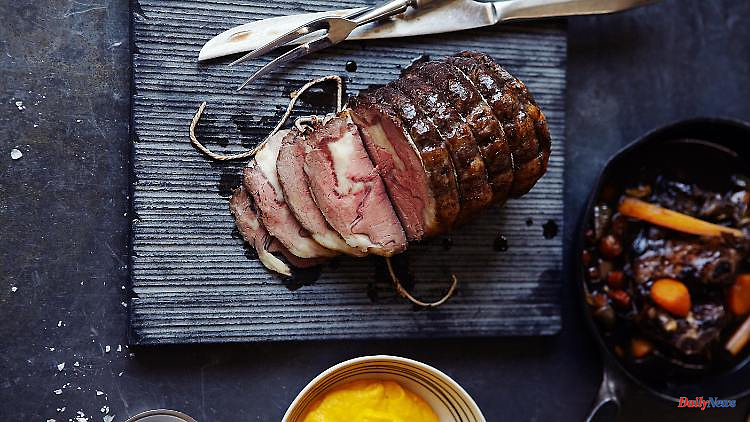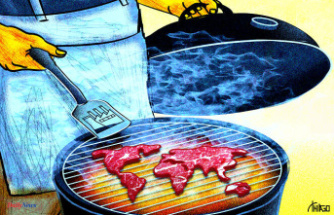The strengths of French cuisine are the best fresh ingredients, regional and seasonal. Star chef Daniel Galmiche combines this with surprisingly atypical side dishes and spices in such a skilfully simple way that every normal household kitchen becomes a gourmet temple.
Once again I can hardly contain my excitement! This book by French two-star chef Daniel Galmiche is modest on the outside: no gold or silver print on the cover, no fancy photo, but an appealing illustration; not huge and thick, but rather in a handy format with a normal weight. But all this harmonizes perfectly with the content of Galmiche's book "French country kitchen", whereby the work is by no means "lightweight" - the book has at least 240 pages with a sheer multitude of recipes. You can also find these magical illustrations inside the book. They illustrate the heartfelt feeling of country love that arises in Daniel Galmiche's dishes. Of course there are also appetizing food photos, just not for every recipe. The space is used well to accommodate as many recipes as possible.
"French country cuisine/recipes from the fields, forests and coasts" was published by ars vivendi and has been in stores since the beginning of August. At first, I stumbled upon the term "star chef of French origin" for a genuine Frenchman, which can be found in various publications. Born in Lure in the Haute-Saône department in 1958 and also raised in this eastern French region of Franche-Comté, Galmiche is clearly a French chef - but he doesn't cook in a typically French way (anymore). But what is "typical" anyway? After completing his education in France, he earned his merits not only there, but also in England, Scotland, Singapore, Sweden and Portugal; he cooked in Abu Dhabi and Dubai, in Malta and Mauritius.
And so it is that Galmiche's cooking style is unquestionably French, yet his interpretation differs from most of his French peers. He creates light dishes with Mediterranean and Asian influences. Technical techniques such as drying, smoking and sous-vide cooking are used in a contemporary way and, for example, in this book they are so skilfully simplified that anyone in a normal household can use them - without having to buy expensive equipment.
It is not for nothing that French cuisine is one of the best in the world. But there's always room for improvement - isn't there? That's why Galmiche strives to make French cuisine more versatile, to make it cautiously more flexible. He succeeded. Today the master chef is considered one of the most important representatives of modern French cuisine.
The man who walked through his grandparents' kitchen as a five-year-old Stippi and loudly announced: "When I grow up, I'll be a chef!" actually became a chef. What we consumers tend to forget: it's a long and hard road to get there. And for the men and women who wear the chef's hat, it's a strenuous, demanding, and family-unfriendly job. They all need a lot of love and perseverance for their job in order to achieve their goal: to make us eaters happy. "Commitment, focus, discipline and passion are essential if you want to be a good, successful chef," writes Daniel Galmiche. Today he appears regularly on television, has two Michelin stars and various other honors and writes cookbooks. "Französische Landküche" is not his first, but his first to be published by ars vivendi.
Two of his cooking colleagues, who have become friends, have their say in the book. "I have great respect for the man, the craftsman, his talent, his passion, his cooking style and also the love he has for ingredients, for nature and his colleagues. A man completely to my taste.", writes Raymond Blanc, head chef at "Le Manoir aux Quat' Saisons" in Great Milton/Oxfordshire. Heston Blumenthal, founder and executive chef of The Fat Duck in Bray, Berkshire, who has enjoyed forays into the great outdoors with Daniel Galmiche, writes, "A trip to the country is possible for all of us, and Daniel has grouped the recipes by environment , from fields to farms and from orchards to rivers, so no matter what you have access to, you will find inspiration in this book.His way of cooking pays respect to both tradition and innovation, mixed with enthusiasm and curiosity for the most diverse Ingredients."
This is the strength of French cuisine: the processing of regional and seasonal ingredients. Daniel Galmiche also prefers to process everything that nature around him has to offer in the different seasons. That is why the best ingredients from the forest, fields, meadows, streams, hedges, gardens and farms find their way into his pots. Away from star cuisine, he pays respect to the ingredients and orientates himself towards French rural cuisine. In his introduction to "French Country Kitchen", the author explains how this came about. We learn a lot from his childhood when he was always "surrounded by gourmands"; from his apprenticeship: "I was enthusiastic about cooking from the very beginning, even though it was hard, such as cleaning the stove and changing the coals in the early morning, in winter, as a punishment if the performance was not right."; from the beginning of his career as a highly decorated chef: "By the time I finally entered the culinary world of France, the classic principles of French cuisine were in my blood and I applied them rigorously. I strived for perfection, honing my skills and gaining experience [.. .]".
After "The Brasserie Cookbook", which focuses on Galmiche's roots and French cuisine, he wanted to reflect the changes that are taking place in French cuisine as well as in other countries. The Corona lockdown apparently gave the final impetus for a new cookbook: He realized "that the return to simplicity would be important for people. [...] The time and space that the lockdown offered me gave me the opportunity to reflect on what was happening across the country and how it was changing our eating habits. I took long walks every day - like many of us - and the ideas took shape. I became more aware of the seasons and what foods they offer us. And I felt more gratitude and respect towards the farmers."
The book has seven chapters based on Galmiche's forays into nature: From the forest
French classics such as Poulet au Pot, Crêpe Suzette or Tarte Tatin are given a modern interpretation à la Galmiche. If you don't know what you can do with celery leaves, flip through the book. Or have you ever crystallized celery leaves? I don't, so this is high on my fall to-do list, along with stewing pointed cabbage in a mixture of chili, ginger, and honey. I can not wait for it!
Fans of fine dining will also find what they are looking for with exquisite ingredients such as scallops, langoustines or quail. But mainly, Daniel Galmiche returns to the basics of all cooking. However, simple does not mean boring - Galmiche's everyday recipes are quite sophisticated: In the "Lasagne" pumpkin slices are stacked on top of each other instead of lasagne plates, potato soups are made into smart creations with wild asparagus and wild garlic or with stinging nettles and watercress, and the long-ignored turnips celebrate their revival at Galmiche . Or: With Galmiche, the absolute classic among stews – Boeuf Bourguignon – is prepared with venison instead of beef and seasoned with dark chocolate and star anise. Even in the hottest summer heat I can hear the Christmas bells ringing in my garden shed in Brandenburg!
Unusual side dishes and spices ensure the wow effect; You can feast anywhere in the world: ginger, tonka beans, cardamom, star anise, lemongrass, Sichuan pepper, saffron... There is only one thing you won't find here, and to my great delight: the notorious foie gras (foie gras). In fact, Daniel Galmiche is committed to eco-friendly and healthy products, to respect for animals. Voila!
(From Meadow, Stream and Hedge / Spring)
"There are a few dishes with raspberries and herbs in this chapter, but I can assure you that they are all very different. Here, lime zest, crème fraîche and rosemary bring a unique balance to this crisp Breton shortcrust dessert."
Preparation: 25 minutes, plus 20 minutes steepingCooking time: 30 minutes
Preparation: 1. Preheat the oven to 170 °C. For the shortcrust pastry, sift together the flour and baking powder in a bowl. In a separate bowl, use a hand mixer to beat the sugar, butter, salt and egg yolks until light and fluffy. Fold in the flour mixture and lime zest to form a soft batter. Roll out between two sheets of baking paper to a thickness of 1 cm, place on a baking tray and remove the top paper. Bake in the oven for 12-18 minutes until lightly golden. Then remove and immediately cut out an 18 cm square while the dough is still soft and pliable. Leave to cool on the parchment paper.
2. For the crème pâtissière, heat the milk in a saucepan over low heat. Scrape out the pulp of the vanilla pod with a sharp knife, whisk in the milk and add the pod as well. Heat the milk to boiling point, remove from the heat, cover with cling film and leave to stand for 20 minutes. Remove the vanilla bean, drain and pat dry on kitchen paper so that it can be used again.
3. Meanwhile, in a bowl, beat the egg yolks and sugar with a whisk until light and fluffy. Gradually stir in the cornstarch, stirring vigorously after each addition to avoid lumps. Slowly pour half of the vanilla milk into the egg mixture while whisking. Pour the mixture back into the saucepan with the remaining milk and heat on a medium-low setting, stirring constantly, until thickened, about 10 minutes. Remove from the heat, add the butter and lime juice and continue beating until the cream has cooled and has a wonderfully smooth, pudding-like texture.
4. Spread a layer of crème pâtissière on the shortcrust pastry square, about 5 mm thick, leaving a small border around it. Arrange the raspberries in neat rows so that they completely cover the cream. Dust with some icing sugar, then garnish with lime zest and some rosemary. Mix the remaining rosemary into the crème fraîche and fill a piping bag. Squirt small dots of crème fraîche on every other raspberry and place a tiny speck of rosemary on each dot.
(From Orchard and Garden / Summer)
"For me, this classic tart represents everything I love about the Mediterranean: climate, colours, heat, scents and fresh regional and seasonal ingredients. Confit tomatoes, chili and lemon thyme give the tart freshness and a fantastic depth of flavor. You can use the tarts Garnish with a few rocket leaves."
Prep: 20 minutes, plus salad preparation Cooking time: 3-3 ½ hours
Preparation: 1. Preheat the oven to 150 °C and line a baking tray with baking paper. Scatter the plum tomato slices on top, drizzle with half the olive oil, sprinkle with a third of the lemon thyme and season with salt. Bake in the oven for 2 hours, turning once halfway through. The tomatoes are ready when they have dried and shrunk a little. Otherwise bake for another 30 minutes. Leave to cool on the sheet.
2. Increase the oven temperature to 180°C. Cut out four circles (approx. 10 cm in diameter) from the puff pastry and prick them several times with a fork. Place the dough discs on a baking sheet lined with baking paper and cover with a second sheet. Put the whole thing in the oven and bake the puff pastry for 10-12 minutes until golden brown. Carefully remove the top baking sheet and allow the dough slices to cool.
3. Meanwhile, use a sharp knife to cut a cross across the bottom of the regular tomatoes. In a heatproof bowl, cover with boiling water. Allow to steep for 30 seconds, then lift out with a slotted spoon and immediately transfer to a bowl of ice cold water. Remove, peel off the shell and discard. Quarter the tomatoes, remove the seeds and roughly dice the flesh.
4. Heat a sauté pan over medium-high. Add the remaining olive oil and the diced tomatoes and sauté for a few minutes until they release their juice. Mix in the garlic, onion and chilies, reduce the heat to medium-low and simmer gently for 20-30 minutes, until the mixture is thick and very soft. Stir occasionally to keep the vegetables from sticking to the bottom of the pan or burning. Season to taste with salt and pepper, then stir in another third of the lemon thyme and the extra virgin olive oil.
5. Spread the tomato mixture over the circles of dough. Place the confit slices on top, overlapping slightly. Drizzle with a little more extra virgin olive oil and sprinkle with the remaining lemon thyme. Place back in the oven for 5-8 minutes to reheat. Serve the warm tarts with a chicory and radish salad.
(From forest
Prep: 35 minutes, plus at least 10 hours refrigerationCook Time: 10 hours overnight, plus 2 hours
Preparation: 1. Preheat the oven to 70 °C. Place the rabbit legs on a baking sheet, season with salt and pepper, drizzle over the oil and sprinkle with thyme leaves. Cover with parchment paper and cook in the oven overnight or at least 10 hours. The next day, remove the baking sheet from the oven and set aside.
2. Increase the oven temperature to 160°C. Spread the silver onions and spring onions on a baking sheet, brush with oil and cook for 20 minutes. Remove the spring onions and set aside. Bake the silver onions for another 25 minutes. Remove from the oven, set aside and reduce the oven temperature back to 70°C.
3. Place the rabbit fillets on a baking sheet, salt and cook in the oven for 12 minutes until tender. Then set aside. Remove the rabbit thigh meat from the bones and place in a large bowl. Strain the gravy through a fine sieve into a saucepan. Bring to a boil, then reduce heat to medium-low and simmer gently, until reduced by two-thirds, about 10 minutes. Using two forks, pluck the thigh meat into pieces, then stir in the parsley and reduced liquid.
4. Line a terrine dish (24cm x 10cm, 8cm deep) with cling film so that the film overhangs on both sides. Cover the bottom with part of the rabbit meat mixture. Arrange the silver onions evenly spaced in the center of the terrine. Add more rabbit meat mixture, then arrange half of the fillets side by side lengthways in the middle. Scatter half the scallions on either side of the fillets and top with more meat mixture. Repeat with the remaining fillets and spring onions and top with the rest of the meat mixture. Fold the excess cling film over the tureen to completely cover it. Weigh down with a weight (1-2 kg, e.g. a packet of sugar). Leave in the fridge for at least 10 hours or overnight.
5. For the onion jam, heat the oil in a saucepan over a moderately low level. Gently sauté the onions in it for 15 minutes. Meanwhile, in a bowl, dissolve the sugar in the apple cider vinegar. Add the vinegar solution to the onions along with the wine, balsamic vinegar and thyme. Bring to a boil over medium-high, reduce heat to medium and simmer for 15 minutes, stirring occasionally. Lower the heat again and simmer for another 10 minutes, until the liquid has thickened to a syrupy consistency. Allow to cool completely, discard the thyme, pour the jam into a sterile jar and cover with a lid. Serve the terrine with the onion jam. It can be stored in the refrigerator for up to 2 months.
(From Barn and Farm / Fall and Winter)
"You can smoke the duck breast yourself at home, or use cold-smoked, air-dried duck to serve sliced on hot lentils in a salad. I love both, and I usually make my decision based on the weather. Either way, I get it You get the best results when processing grain-fed free-range poultry."
Preparation: 20 minutes Cooking time: 35 minutes
Preparation: 1. Cut the zest of the orange into fine strips using a zester. In a small saucepan, cover with water and bring to a boil over medium-high. Remove from the heat, drain, rinse under cold running water and drain. Repeat this process.
2. Return zest to saucepan, add sugar and 3 tablespoons water and heat on low, stirring, until sugar is dissolved. Increase the heat to medium, bring the water to a boil, then immediately turn the heat down to low and simmer for 4-5 minutes, until the zest is translucent. Remove from the heat and allow the zest to cool in the syrup.
3. Place a large piece of aluminum foil, shiny side down, on the bottom of a wok or pressure cooker. Add rice, tea, sugar and 1 whole sprig of lavender and drizzle with rapeseed oil. Put a grate or the steamer insert on top and close with the lid. Heat on medium for 5 minutes until mixture begins to smoke. Quickly place the duck breasts on the grid, cover with aluminum foil and the lid and smoke on low for 5 minutes.
4 Meanwhile, in a small saucepan, cover the lentils with cold water. Bring to the boil and skim off the foam that rises to the surface. Add onion, cloves and bouquet garni. Reduce the heat to low and simmer the lentils until just tender, 5-7 minutes. Season with salt and pepper, drain and discard the spices.
5. When the duck is almost done, heat a non-stick skillet over medium-high. Set the stovetop under the smoker and lift out the meat. Place skin-side down in pan and fry for 4-5 minutes, then turn and brush skin with honey. Sprinkle some lavender on top and fry for another 5 minutes. Remove and let rest under aluminum foil.
6. Melt the butter in a non-stick frying pan over medium-high. Fry the lentils in it while stirring constantly. Cut the duck breasts into pieces and serve on top of the lentils, garnished with crystallized orange zest and drizzled with a little syrup. Finally add some chervil and 1 pinch of lavender to each serving.
(From field
"I think swedes have been ignored for too long but are finally making a small comeback. They definitely make a great addition to a warming winter soup, and the slices of caramelized chestnuts are a great accompaniment."
Prep: 20 minutes, plus broth preparationCooking time: 55 minutes
Preparation: 1. Preheat the oven to 200 °C. Spread the diced swedes on a baking tray, drizzle with olive oil and season with a little salt and pepper. Bake in the oven for 5 minutes, then mix in the pumpkin cubes so that they are coated all over with oil. Place back in the oven and roast for an additional 7-10 minutes, until the vegetables are brown on the edges but not cooked through. Remove from the tray and drain on kitchen paper.
2. Meanwhile, melt the butter in a large saucepan over medium-high. Sauté the onion in it for 3-4 minutes until soft and translucent. Add the baked vegetables and toss in the pot. Add broth, cream and milk and bring to a boil. Remove from the stove and reduce the temperature to low. Simmer uncovered for about 30 minutes, until the vegetables are very soft. The soup must not boil, otherwise the cream will curdle.
3. While the soup is cooking, for the caramelized chestnuts, melt the butter in a non-stick pan over medium-high. As soon as it foams, add chestnuts and sugar. Let the chestnuts caramelize for 3-4 minutes, turning once halfway through and being careful not to burn them. Slide out of the pan onto baking paper and let cool until crisp. Then cut into slices.
4. When the soup is ready, use a spoon to pour the soup into the blender (depending on the blender, this may have to be done in several batches) and puree until smooth. Strain through a fine sieve into a clean saucepan. The soup should have a very creamy and velvety consistency. Season with salt and pepper and warm gently. If it's too thick, stir in a little more broth. To serve, drizzle a little extra virgin olive oil over each serving and garnish with a few caramelized chestnuts.
The book has a ribbon marker - I needed at least ten! Let yourself be captivated by this wonderful, new French lightness; Heidi Driesner wishes you lots of fun.












